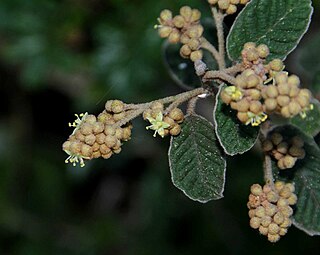
Pomaderris oraria, commonly known as Bassian dogwood, is a species of flowering plant in the family Rhamnaceae and is endemic to south-eastern Australia. It is a compact shrub with hairy branchlets, hairy, elliptic leaves and panicles of hairy, greenish to cream-coloured or crimson-tinged flowers.

Pomaderris paniculosa, commonly known as scurfy pomaderris, is a species of flowering plant in the family Rhamnaceae and is native to Australia and New Zealand. It is a shrub with hairy branchlets, round to elliptic or egg-shaped leaves with the narrower end towards the base and panicles of hairy, cream-coloured to greenish, sometimes crimson-tinged flowers.

Pomaderris lanigera, commonly known as woolly pomaderris, is a species of flowering plant in the family Rhamnaceae and is endemic to south-eastern continental Australia. It is a shrub or small tree with hairy stems, lance-shaped to egg-shaped or elliptic leaves, and hemispherical clusters of yellow flowers.

Pomaderris vellea, commonly known as woolly pomaderris, is a species of flowering plant in the family Rhamnaceae and is endemic to eastern Australia. It is an erect shrub with curly-hairy stems, oblong to circular leaves, and dense panicles of yellow flowers.

Pomaderris queenslandica, commonly known as scant pomaderris, is a species of flowering plant in the family Rhamnaceae and is endemic to eastern Australia. It is a shrub with woolly-hairy stems, egg-shaped to narrowly elliptic leaves, and panicles of creamy-yellow flowers.

Pomaderris aurea is a species of flowering plant in the family Rhamnaceae and is endemic to Victoria, Australia. It is a shrub with hairy branchlets, egg-shaped or elliptic leaves and panicles of golden yellow flowers.

Pomaderris bodalla, commonly known as Bodalla pomaderris, is a species of flowering plant in the family Rhamnaceae and is endemic to New South Wales. It is a shrub with hairy young stems, elliptic to more or less rhombic leaves, and dense clusters of cream-coloured flowers.

Pomaderris brunnea, commonly known as rufous pomaderris, is a species of flowering plant in the family Rhamnaceae and is endemic to south-eastern Australia. It is a shrub with hairy stems, elliptic to lance-shaped leaves with the narrower end towards the base, and dense panicles of yellowish flowers.
Pomaderris clivicola is a species of flowering plant in the family Rhamnaceae and is endemic to a restricted area of Queensland. It is a multi-stemmed shrub with softly-hairy twigs, egg-shaped leaves, and small panicles of yellow to cream-coloured flowers.
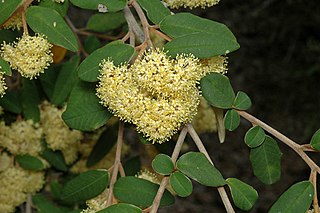
Pomaderris costata is a species of flowering plant in the family Rhamnaceae and is endemic to south-eastern continental Australia. It is a spreading shrub with densely hairy branchlets, egg-shaped to elliptic leaves, and panicles of cream-coloured or white flowers.
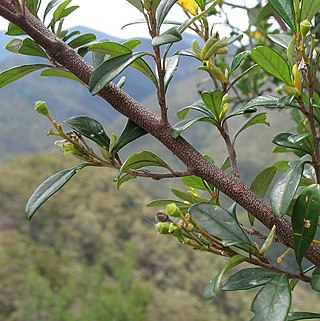
Pomaderris gilmourii is a species of flowering plant in the family Rhamnaceae and is endemic to Deua National Park in New South Wales. It is a shrub with hairy young stems, egg-shaped to elliptic leaves, and clusters of silvery buds and creamy-yellow flowers.

Pomaderris helianthemifolia is a species of flowering plant in the family Rhamnaceae and is endemic to south-eastern continental Australia. It is a bushy shrub with hairy young stems, narrowly elliptic to lance-shaped leaves with the narrower end towards the base, and small panicles of hairy yellowish flowers.
Pomaderris notata, commonly known as McPherson Range pomaderris, is a species of flowering plant in the family Rhamnaceae and is endemic to eastern Australia. It is a shrub with woolly-hairy stems, elliptic leaves, and cream-coloured flowers.

Pomaderris pallida, commonly known as pale pomaderris, is a species of flowering plant in the family Rhamnaceae and is endemic to the south-east of continental Australia. It is a compact, rounded shrub with hairy stems, narrowly elliptic to narrowly oblong leaves and panicles of cream-coloured flowers.

Pomaderris pauciflora is a species of flowering plant in the family Rhamnaceae and is endemic to the south-east of continental Australia. It is a shrub with hairy stems, mostly lance-shaped leaves with the narrower end towards the base, and panicles of cream-coloured flowers.
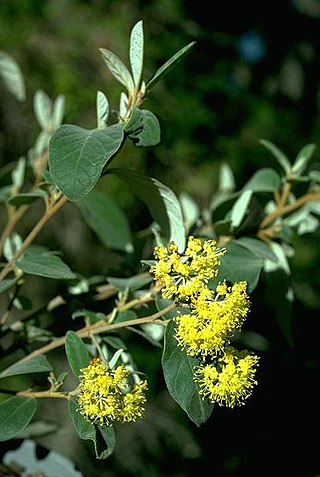
Pomaderris pilifera is a species of flowering plant in the family Rhamnaceae and is endemic to south-eastern Australia. It is a shrub with hairy branchlets, egg-shaped leaves, and large panicles of lemon-yellow flowers.

Pomaderris reperta, commonly known as Denman pomaderris, is a species of flowering plant in the family Rhamnaceae and is endemic to a restricted area of New South Wales. It is a shrub with densely rusty-hairy new growth, egg-shaped to elliptic leaves, and dense panicles of cream-coloured flowers.
Pomaderris sericea, commonly known as bent pomaderris or silky pomaderris, is a species of flowering plant in the family Rhamnaceae and is endemic to south-eastern continental Australia. It is a shrub with silky-hairy new growth, narrowly elliptic leaves and panicles of yellow flowers. It is only known from three small populations and has not been seen since 1997.
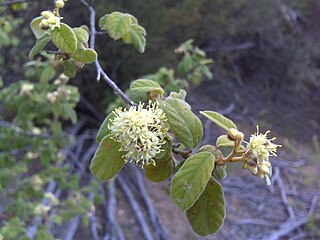
Pomaderris subcapitata is a species of flowering plant in the family Rhamnaceae and is endemic to south-eastern continental Australia. It is a shrub with hairy stems, elliptic to egg-shaped leaves and dense clusters of cream-coloured or yellow flowers.
Pomaderris tropica is a species of flowering plant in the family Rhamnaceae and is endemic to Walshs Pyramid in north Queesland. It is a shrub with softly-hairy branchlets, egg-shaped to elliptic leaves and clusters of white to cream-coloured flowers.

















